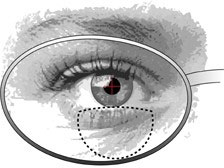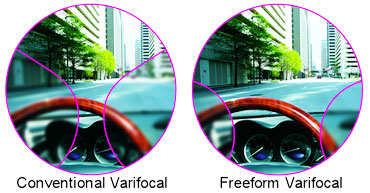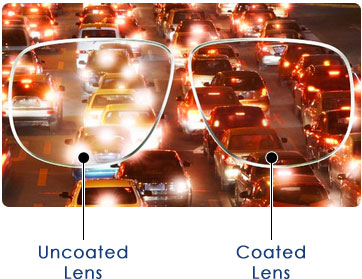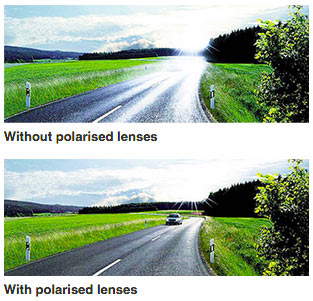Lenses




Select a lens...
Single Vision Lenses
Single vision lenses have one single prescription across the entire surface of the lens and suitable in all scenarios, whether you need your glasses for driving, working or reading.
Concave lenses are used to correct short sight and convex lenses to correct long sight. Concave lenses are generally thinner in the centre than they are at the edge and convex lenses are usually thinner at the edge than at the centre. The curvature of the lens, its thickness and weight will depend on the amount of long or short sight it is designed to correct. The lens material will also influence the thickness and weight of your lenses, as will the size and shape of the spectacle frame you choose. Traditionally spectacle lenses were made of glass, but most lenses are now lightweight, plastic and there is a wide range of materials available to suit your prescription and lifestyle.

If you need to wear glasses for both distance and near vision, you could wear separate pairs of single vision glasses dedicated to each task. However, the preferable option would be to consider the benefits of Varifocals.
High-Index and Aspheric Lenses
If you need high-powered lenses you can improve the weight or appearance of your glasses with special lens materials and designs. High-index materials and aspheric designs mean that lenses can now be made thinner, lighter and better looking than traditional lens types. High-index materials make lenses for short sight thinner, while aspheric designs that minimise the amount of material make lenses for long sight both thinner and lighter. It is important to remember that not all lenses are the same and that is why we offer quality lenses sourced from all around the world at affordable prices. Zeiss, Nikon, Hoya and Essilor are just some of the lenses we use. These lenses will provide you with the thinnest materials and best coatings available.
Bifocal Lenses
After the age of 40, you may begin to notice the symptoms of presbyopia (blurred near vision), including the feeling that your arms "aren't long enough" to hold a newspaper or magazine at a position where you can read it clearly. If you already wear prescription eyeglasses, this generally means you will need to begin wearing multifocal lenses to continue to see clearly at all distances. While most presbyopes these days choose line-free progressive lenses, conventional bifocals have some advantages over progressives. In particular, bifocals usually provide wider lens areas for distance vision and near vision. Bifocals are typically placed so the line rests at the same height as the wearer's lower eyelid. This ensures that when the wearer looks straight ahead, they see distance vision. As the bifocal wearer drops there eyes downwards to read, the eyes naturally see out the near-vision portion of the lens, which enables the wearer to read at a set distance. Bifocals eliminate the need to swap and change between different pairs of glasses. They are very easy to use, and most people adapt in a day or two. If your interested in trying these lenses or require any advice regarding our lens options, please contact one of our experienced dispensing team.

Varifocal Lenses
Varifocals also called Multifocals, or Progressive Lenses allow the user to see clearly at all distances. The prescription changes seamlessly from distance at the top of the lens, to reading at the bottom, with no visible line through the glasses (making them cosmetically superior to Bifocals). They also include a section where the prescription is ideal for computer use (or any other intermediate distance tasks). Varifocals can be made in all the same materials as single vision lenses, including thinner, anti-reflection and transition lenses. We use the latest varifocal designs to ensure you adapt as quickly as possible to your new varifocals. The right lenses are crucial to good vision and comfortable spectacle wearing. They differ from eye to eye. We will give you comprehensive advice on choosing the best lenses for you and have a vast selection to choose from. We source our lenses from the world's top manufacturers such as Hoya, Essilor, Zeiss, Nikon and Kodak. Come and see for yourself!

Occupational Lenses
Occupational lenses also called computer lenses are the ideal solution for office workers and VDU users. The problem with normal single vision lenses is they only allow you to see at one particular distance, whether it be your reading material or the computer screen. However most computer users often require 2 or more different working distances, close up and for the screen. Occupational lenses solve this issue as they can be tailored for various near vision tasks. So when using the lenses you will be suitable for computer and DIY work. The added benefit of Occupational lenses over varifocals, is that they will give you a wider field of view for intermediate and near vision tasks.
Lens Coating
Anti-glare
Spectacle lenses lose approximately 8% of the available light through reflection from the external and internal surfaces of the lens. This has two main consequences for spectacle wearers. Their eyes don't receive as much light as they would, and their eyes are not as visible to others because they are 'hidden' behind distracting reflections. Adding an anti-reflection coating to the lenses vastly reduces the amount of light lost by surface reflection - often to under 1%. Cosmetically this significantly improves their appearance. The picture illustrates the difference that coated lenses (on the right hand side of the picture) can make. Not only is it more flattering, but it also aids 'non-verbal' communication. The optical advantage of the coating is most noticeable in low lighting, when the eyes need as much of the available light as possible. Night driving is probably the best example to show the benefits of anti-reflection coated lenses - the effects of oncoming headlight glare (see the comparison below); the presence of 'ghost' images (bright light sources repeated more faintly elsewhere on the lens as a result of internal reflections); and visual contrast are all areas where coated lenses can help the wearer significantly.

Polarised Lenses
All sunglasses are designed to reduce brightness, but glare from the sun can still cause eye strain, squinting or even temporary blindness. This can be particularly hazardous whilst driving. To avoid this, we at Stephen H Davis Optometrists recommend polarised lenses, which provide 100% protection from glare and block 100% of UV rays.
Visible light waves from the sun travel in all directions. When sunlight reflects off a horizontal surface (like a wet road, a glass, a metallic surface or off water), it often becomes concentrated horizontally which causes the waves to be scattered. This is known as glare. Polarised lenses are not only tinted they also incorporate a special filter that blocks glare and only allows the useful vertical light to enter the eye.
Polarised Lenses are ideal for:
-
Fishing - anglers will be able to see 'through' the water.
-
Driving - drivers will no longer be affected by sudden glare or low winter sun.
-
Skiing or snowboarding - skiers will begin to see 'hidden' bumps in the snow.

Photochromic Lenses
These are variable tint lenses (often called by trade names such as Reactolight, Reactions, Transitions and Sensity). They change to darkness depending on the brightness of the sun. Inside they appear clear, but as soon as you go out into the sun, they can darken within a minute. They can become as dark as a sunglass tint in full sunlight. Our photochromic lenses are also designed with a scartch resistance coating. We at Stephen H Davis, use the world renowned Transitions, as well as Hoya's Technological advanced Sensity lenses. It is possible to combine Photochromic and Hi Index in one lens.
Prescription Sunglasses
Whatever your prescription, it is important to protect the eyes against excessive ultraviolet (UV) radiation. Protection is needed to avoid reflected light from sand and snow or if you spend long periods of time outdoors, particularly in the summer. Prescription sunglasses can be made with single-vision, bifocal or varifocal designs to offer the same standard of protection as non-prescription sunglasses.














